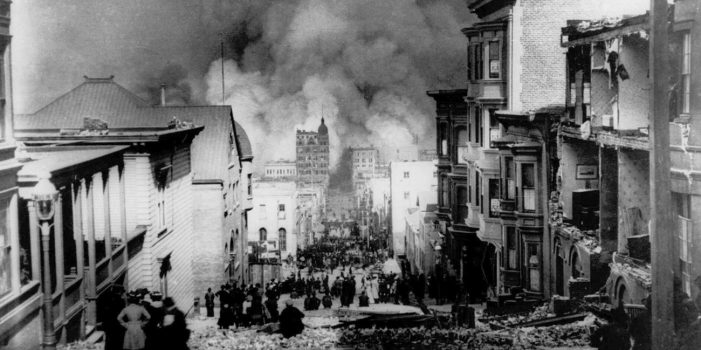On April 18th, 1906, an earthquake now estimated at the vicinity of 8.0 on the Richter scale struck San Francisco, California, killing hundreds of people as it toppled numerous buildings and started fires that engulfed whole neighborhoods. Are you prepared to cope with such a disaster?
- Ad SOURCE FOR IVERMECTIN / HCQ, ANTIBIOTICS, ALL REGULAR MEDS“Mygenericstore” is a well-established pharmacy service that deals primarily with generic medicines produced by quality-assured manufacturers from developing countries.
- Ad California Legal Rifles & Pistols!Get the firepower necessary to survive in restrictive states! WBT offers California & other state compliant rifles from any brand you want.











I’ll never forget reading this passage about the earthquake: The Mizpah Café
The Gathering Place
The outlines of this particular disaster are familiar. At 5:12 in the morning on April 18, 1906, about a minute of seismic shaking tore up San Francisco, toppling buildings, particularly those on landfill and swampy ground, cracking and shifting others, collapsing chimneys, breaking water mains and gas lines, twisting streetcar tracks, even tipping headstones in the cemeteries. It was a major earthquake, centered right off the coast of the peninsular city, and the damage it did was considerable. Afterward came the fires, both those caused by broken gas mains and chimneys and those caused and augmented by the misguided policy of trying to blast firebreaks ahead of the flames and preventing citizens from firefighting in their own homes and neighborhoods. The way the authorities handled the fires was a major reason why so much of the city — nearly five square miles, more than twenty-eight thousand structures — was incinerated in one of history’s biggest urban infernos before aerial warfare. Nearly every municipal building was destroyed, and so were many of the downtown businesses, along with mansions, slums, middle-class neighborhoods, the dense residential-commercial district of Chinatown, newspaper offices, and warehouses.
The response of the citizens is less familiar. Here is one. Mrs. Anna Amelia Holshouser, whom a local newspaper described as a “woman of middle age, buxom and comely,” woke up on the floor of her bedroom on Sacramento Street, where the earthquake had thrown her. She took time to dress herself while the ground and her home were still shaking, in that era when getting dressed was no simple matter of throwing on clothes. “Powder, paint, jewelry, hair switch, all were on when I started my flight down one hundred twenty stairs to the street,” she recalled. The house in western San Francisco was slightly damaged, her downtown place of business — she was a beautician and masseuse — was “a total wreck,” and so she salvaged what she could and moved on with a friend, Mr. Paulson. They camped out in Union Square downtown until the fires came close and soldiers drove them onward. Like thousands of others, they ended up trudging with their bundles to Golden Gate Park, the thousand-acre park that runs all the way west to the Pacific Ocean. There they spread an old quilt “and lay down . . . not to sleep, but to shiver with cold from fog and mist and watch the fl ames of the burning city, whose blaze shone far above the trees.” On their third day in the park, she stitched together blankets, carpets, and sheets to make a tent that sheltered twenty-two people, including thirteen children. And Holshouser started a tiny soup kitchen with one tin can to drink from and one pie plate to eat from. All over the city stoves were hauled out of damaged buildings — fire was forbidden indoors, since many standing homes had gas leaks or damaged flues or chimneys — or primitive stoves were built out of rubble, and people commenced to cook for each other, for strangers, for anyone in need. Her generosity was typical, even if her initiative was exceptional.
Holshouser got funds to buy eating utensils across the bay in Oakland. The kitchen began to grow, and she was soon feeding two to three hundred people a day, not a victim of the disaster but a victor over it and the hostess of a popular social center — her brothers’ and sisters’ keeper. Some visitors from Oakland liked her makeshift dining camp so well they put up a sign — “Palace Hotel” — naming it after the burned-out downtown luxury establishment that was reputedly once the largest hotel in the world. Humorous signs were common around the camps and street-side shelters. Nearby on Oak Street a few women ran “The Oyster Loaf ” and the “Chat Noir” — two little shacks with their names in fancy cursive. A shack in Jefferson Square was titled “The House of Mirth,” with additional signs jokingly offering rooms for rent with steam heat and elevators. The inscription on the side of “Hoff man’s Café,” another little street-side shack, read “Cheer up, have one on me . . . come in and spend a quiet evening.” A menu chalked on the door of “Camp Necessity,” a tiny shack, included the items “fleas eyes raw, 98¢, pickled eels, nails fried, 13¢, flies legs on toast, .09¢, crab’s tongues, stewed,” ending with “rain water fritters with umbrella sauce, $9.10.” “The Appetite Killery” may be the most ironic name, but the most famous inscription read, “Eat, drink, and be merry, for tomorrow we may have to go to Oakland.” Many had already gone there or to hospitable Berkeley, and the railroads carried many much farther away for free.
It continues at this link: https://www.nytimes.com/2009/08/21/books/excerpt-paradise-built-in-hell.html
The book later tells how the army garrison at the Presidio declared a curfew and kill dozens of citizens “to keep order”. The entire chapter begins with inspiration and ends with
a cautionary tale regarding the powers that be.
A short review:
https://ssir.org/book_reviews/entry/paradise_built_in_hell_extraordinary_communities_disaster_rebecca_solnit